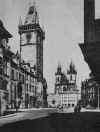In Kafka’s time Prague was in the Austro-Hungarian empire: although the local population spoke largely Czech, German was used for official business and by the upper classes. In 1910, the population of Prague was 230,000, making it the third largest city in the Austro-Hungarian Empire. Including the suburbs, the population was about 600,000. 90.7% of the population spoke Czech and the rest spoke German. The social elite of business managers and entrepreneurs were largely German-speaking: there was essentially no German-speaking proletariat. According to a German tour book of the time,
"In the best pubs and restaurants, and also in the biggest shops German is understood. Coachmen, people in the service industries and railway porters usually understand as much German as they need to deal with foreigners."
Today, English has taken the place of German as the main second language for international business in Prague.
Na Prikope in 1892 (Click for full-sized image) |
|
A Prague street in 1897 (Click for full-sized image) |
|
Staromeske namesti around 1970 (Click for full-sized image) |
Today, Prague is the capital of the Czech Republic, and Czech is the official language. The population is about 1.3 million. The German minority has virtually disappeared: large numbers of German-speakers were forcibly removed from the country after the second world war, and most of the rest have assimilated.
Just as German was the language of the ruling class in Kafka’s day, English is increasingly playing that role today. Much of the media is foreign-owned, most new office buildings are built, funded and rented by foreign companies for other foreign companies; and a large part of the business service industry, such as accountancy firms and real-estate agencies are foreign owned. Many foreign business men are able to work effectively without being able to speak Czech; however, few people can work effectively in top positions unless they know English.
Physically, the centre of Prague looks much the same as in Kafka’s day. The main difference, which can be seen in these photographs, is that large areas of the centre have been pedestrianized. Because of strict planning restrictions, there are relatively few new buildings in the centre. However, over the past century the city has expanded enormously, and much of the population now lives in modern (and very poor quality) apartment blocks in the suburbs.
| Prague taken from a position near the
castle (Click for full-sized image) |
|
| A prague street near the river (Click for full-sized image) |









